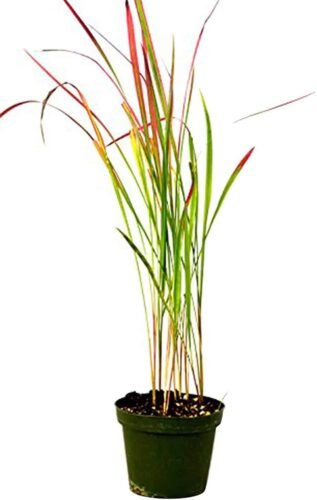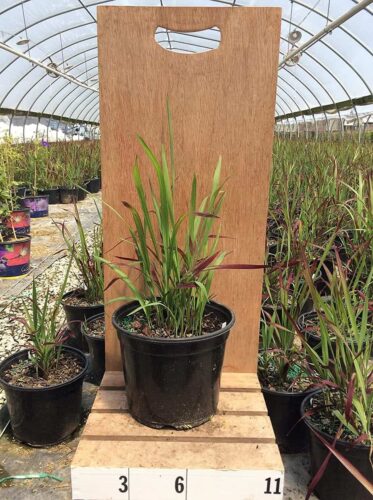Japanese blood grass (Imperata cylindrica) is a striking ornamental grass known for its vibrant red color and unique appearance. However, its allure comes with concerns, especially regarding its classification as a noxious weed in some states. This article aims to provide a comprehensive guide to Japanese blood grass, covering topics ranging from its invasive nature to its impact on canine companions. Additionally, we’ll explore the care and growth aspects of this grass, as well as alternative options like Japanese forest grass (Hakonechloa) that are pet-friendly.
Japanese Blood Grass: A Noxious Weed
Japanese blood grass has gained notoriety due to its invasive tendencies, leading some states to declare it a noxious weed. The virulence of this species in the landscape is a cause for concern, particularly because the red form has the potential to revert to the green form, recognized as one of the 10 most invasive weeds globally. To navigate these challenges, understanding the federal regulations surrounding Japanese blood grass is crucial. The Plant Protection Act designates it as a Federal Noxious Weed, prohibiting its import and transport between states without a federal permit. Warm-weather states like Alabama, Florida, Georgia, Hawaii, Mississippi, North Carolina, and South Carolina have also classified it as a noxious weed, emphasizing the importance of checking local laws before purchasing or planting this grass.
Invasiveness and Virulence
Japanese blood grass is notorious for its invasiveness and virulence in various landscapes. Its ability to spread rapidly can lead to ecological imbalances and impact native flora. The red form’s susceptibility to reverting to the green form adds another layer of complexity, making it essential for gardeners to monitor and manage its growth effectively.
Federal Noxious Weed Status
Under the Plant Protection Act, Japanese blood grass is classified as a Federal Noxious Weed. This designation signifies the need for stringent regulations to control its spread. The federal permit requirement for import and transport underscores the potential ecological threat posed by this ornamental grass.
As an Amazon Associate we earn from qualifying purchases.
Table of Contents
State Declarations
The classification of Japanese blood grass as a noxious weed in specific states further highlights the need for regional awareness. Different climates and ecosystems may influence the grass’s behavior, necessitating state-specific regulations to prevent its uncontrolled spread.
Japanese Forest Grass (Hakonechloa)
Amid concerns about Japanese blood grass, gardeners seeking a pet-friendly alternative can turn to Japanese forest grass, also known as Hakonechloa. This low-growing, soft, and mounding grass thrives in shaded areas, providing a visually appealing and safe option for both cats and dogs. Hakonechloa macra Aureola, a variegated variety with golden yellow blades and dark green striping, offers a cascading and draping habit that suits various landscapes, including slopes, rock gardens, retaining walls, and containers. Slow-growing and clumping, it reaches about 25 cm (10 inches) in height and 45 cm (18 inches) in width. Its adaptability to partial shade and the seasonal interest it adds in autumn make it a desirable choice, earning it accolades such as the ‘Perennial Plant of the Year’ in 2009 and the RHS Award of Garden Merit.
Pet-Friendly and Non-Toxic Nature
Hakonechloa, unlike Japanese blood grass, is known for its pet-friendly and non-toxic characteristics. Both cats and dogs can safely enjoy the foliage without the risk of toxicity. This makes it an excellent choice for households with furry companions, providing an aesthetically pleasing and safe environment.
Description of Hakonechloa macra Aureola
The variegated variety of Hakonechloa, known as Aureola, stands out with its golden yellow blades and narrow dark green striping. Its cascading and draping habit make it a versatile addition to various landscapes, offering aesthetic appeal and visual interest. The seasonal color changes further enhance its desirability.
Awards and Recognitions
Hakonechloa macra Aureola has received prestigious awards, including the title of ‘Perennial Plant of the Year’ in 2009 and the RHS Award of Garden Merit. These accolades speak to its outstanding qualities, making it not only a safe choice for pets but also a celebrated ornamental grass in the gardening community.
Care Guide for Japanese Blood Grass
Caring for Japanese blood grass requires attention to specific details to ensure its optimal growth while mitigating potential invasive tendencies. Following a step-by-step guide can aid in maintaining a healthy and controlled garden environment.
- General Care Tips To foster the well-being of Japanese blood grass, provide it with a well-drained soil rich in organic matter. Regular watering is essential, especially during dry periods, to keep the soil consistently moist. Mulching around the plants helps retain moisture and suppress weed growth.
- Growing Conditions and Preferences Understanding the preferred growing conditions of Japanese blood grass is key to its successful cultivation. It thrives in full sun to partial shade and is adaptable to various soil types. However, it is crucial to avoid waterlogged conditions, as excessive moisture can lead to root rot.
- Propagation Methods for Japanese Blood Grass Propagating Japanese blood grass can be achieved through division. Divide established clumps in spring or early autumn, ensuring that each division has both roots and shoots. This process not only aids in the multiplication of the grass but also helps control its spread.
- Addressing Concerns about Invasiveness Regular monitoring and prompt removal of any green shoots that emerge from the red form can help mitigate the risk of invasiveness. Establishing physical barriers like edging can also prevent the grass from spreading beyond its designated area.
- Checking State Laws Before Purchase or Planting Given the varying regulations in different states, it is imperative to check local laws before purchasing or planting Japanese blood grass. This proactive approach ensures compliance with state-specific restrictions and contributes to responsible gardening practices.

Buy- Japanese Blood Grass
Japanese Blood Grass and Dogs
As a responsible pet owner, understanding the potential impact of Japanese blood grass on dogs is crucial. Addressing common concerns and providing information on the grass’s safety for canine companions can guide pet owners in creating a secure environment.
Overview of Dog-Friendly Ornamental Grasses
Ornamental grasses that are safe for dogs contribute to a pet-friendly garden environment. Understanding the characteristics of dog-friendly grasses allows pet owners to make informed choices that balance aesthetics with the well-being of their furry friends.
Specifics about Japanese Blood Grass and Its Safety for Dogs
Japanese blood grass, when compared to other toxic grass species, is generally considered safe for dogs. However, due to its classification as a noxious weed and the potential for reverting to the invasive green form, precautions should be taken to ensure it doesn’t pose a threat to canine companions.
Concerns about Treated Grass and Its Impact on Dogs
Treated grass, whether with fertilizers or pesticides, can have adverse effects on dogs if ingested. It is essential to be cautious about the products used in the garden and to follow recommended guidelines to prevent unintentional harm to pets.
Frequently Asked Questions
Addressing common questions about Japanese blood grass and related topics provides readers with a comprehensive understanding of the potential challenges and benefits associated with its cultivation.
- Is Japanese Blood Grass Toxic to Dogs and Cats? Japanese blood grass is generally not considered toxic to dogs and cats. However, precautions should be taken to prevent any potential harm, especially considering its classification as a noxious weed in some states.
- ASPCA Guidelines on Japanese Blood Grass Toxicity The American Society for the Prevention of Cruelty to Animals (ASPCA) provides valuable guidelines on the toxicity of various plants, including ornamental grasses. Checking their recommendations ensures adherence to pet safety standards.
- Invasiveness of Japanese Blood Grass Understanding the invasiveness of Japanese blood grass is crucial for gardeners. Implementing preventive measures and adhering to federal and state regulations can help curb its potential impact on the environment.
- Winter Care for Japanese Blood Grass Proper winter care ensures the resilience of Japanese blood grass. Mulching around the plants helps protect the roots, and trimming back the foliage in late autumn prevents snow and ice buildup, promoting a healthy resurgence in spring.
- Information on Height and Spread Knowing the expected height and spread of Japanese blood grass aids in garden planning. This information allows for proper spacing and ensures that the grass complements the overall design of the landscape.
- Companion Plants for Japanese Blood Grass Selecting suitable companion plants enhances the visual appeal of Japanese blood grass. Plants that complement its color, height, and growth habits create a harmonious garden setting.
- Availability of Japanese Blood Grass for Sale Checking local nurseries and reputable online sources ensures access to healthy and regulated Japanese blood grass varieties. Purchasing from reliable sources contributes to responsible gardening practices.
- Pruning Guidelines for Japanese Blood Grass Pruning is an essential aspect of Japanese blood grass care. Knowing when and how to prune prevents the grass from becoming overly dense and maintains its aesthetic appeal throughout the growing season.
Related Questions
Japanese Blood Grass Care in Winter
In winter, provide protection to Japanese blood grass by mulching around the plants to safeguard the roots. Trimming back the foliage in late autumn helps prevent snow and ice buildup, ensuring a healthy resurgence in the spring.
Japanese Blood Grass Height and Spread
Japanese blood grass typically reaches a height of about 25 cm (10 inches) and spreads to approximately 45 cm (18 inches). Knowing these dimensions aids in proper spacing and landscape planning.
When to Cut Back Japanese Blood Grass
Cut back Japanese blood grass in late autumn to maintain its health and appearance. Trimming the foliage before winter helps prevent excessive growth and prepares the grass for the next growing season.
Japanese Blood Grass Care in Florida
Care for Japanese blood grass in Florida involves attention to well-drained soil, regular watering to keep the soil moist, and consideration of the warm climate. Adaptable to various conditions, it’s essential to monitor and prevent potential invasiveness.
Is Japanese Blood Grass Toxic to Dogs
Japanese blood grass is not generally toxic to dogs. While it is considered safe for canine companions, precautions should be taken, especially in regions where it is classified as a noxious weed. Checking state laws is advised.
Japanese Blood Grass Seeds
Japanese blood grass can be propagated from seeds. Collect seeds from mature plants and sow them in well-prepared soil. Ensure proper care and environmental conditions for successful germination and growth.
Japanese Blood Grass Companion Plants
Choosing suitable companion plants enhances the visual appeal of Japanese blood grass. Select plants that complement its color, height, and growth habits, creating a harmonious and aesthetically pleasing garden setting.
Japanese Blood Grass Invasive
Japanese blood grass has invasive tendencies, especially in warm-weather states. To prevent its uncontrolled spread, regular monitoring, prompt removal of green shoots, and compliance with federal and state regulations are essential.
Japanese blood grass for sale
Japanese blood grass for sale is going on various website and i have given some website links so you can purchase them directly from there. Here is the link for .
Red baron grass for sale
Red baron grass is for sale Sale and this grass(Imperata cylindrica) easily been grown by me many times and i will be providing where you can buy it and it is available in online stores so you don’t need to buy it offline, it will be delivered to your house. Here is the link.

Japanese Blood Grass ‘Red Baron’

Conclusion
In conclusion, Japanese blood grass presents both aesthetic appeal and potential challenges for gardeners, particularly in regions where it is classified as a noxious weed. By understanding its characteristics, adhering to federal and state regulations, and exploring pet-friendly alternatives like Hakonechloa, gardeners can strike a balance between cultivating visually pleasing landscapes and ensuring responsible environmental practices. The comprehensive care guide and answers to frequently asked questions contribute to a well-rounded understanding of Japanese blood grass, empowering readers to make informed decisions for their gardens and the well-being of their canine companions.
© 2024 Lotusmagus.com. All rights reserved. This content is protected by copyright. Visit Lotusmagus.com for more information.
